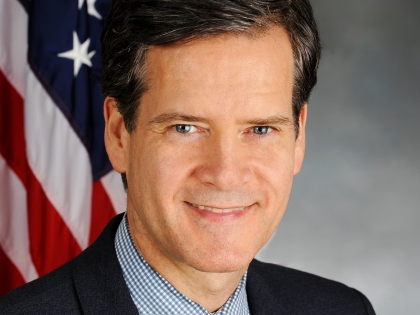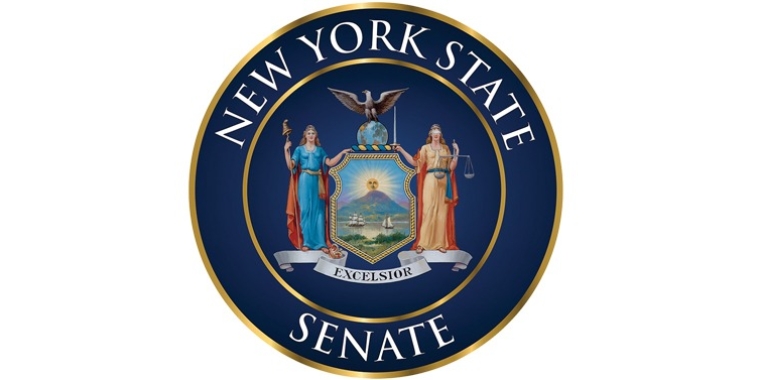
Hoylman and Elected Officials Demand Transparency, Community Input at Council Hearing on East Side Coastal Resiliency Project
January 23, 2019
NEW YORK- Senator Brad Hoylman (D/WF-Manhattan) submitted testimony today alongside the offices of State Senator Brian Kavanagh, Congressmember Carolyn Maloney, Congressmember Nydia Velazquez, Assemblymember Harvey Epstein, and Assemblymember Yuh-Line Niou before the City Council Committee on Parks and Recreation and the Committee on Environmental Protection regarding the status of the City’s East Side Coastal Resiliency Project.
The testimony can be read in full below.
###
Thank you for the opportunity to present testimony during this New York City Council Oversight hearing on the status of the East Side Coastal Resiliency (ESCR) Project. We are State Senator Brad Hoylman, State Senator Brian Kavanagh, Congressmember Carolyn Maloney, Congressmember Nydia Velázquez, Assemblymember Harvey Epstein, and Assemblymember Yuh-Line Niou. Each of our respective districts includes a large portion of the area that would be affected by the City of New York’s proposed East Side Coastal Resiliency (ESCR) project, the subject of today's oversight hearing.
We thank Parks and Recreation Committee Chair Barry Grodenchik and Environmental Conservation Committee Chair Costa Constantinides for holding this important hearing and for the opportunity to present this joint testimony, and Councilmembers Carlina Rivera, Margaret Chin, and Keith Powers, with whom we have worked closely on this issue, for your leadership.
While we applaud the City’s desire to take decisive action in response to the urgent risks of extreme weather driven by global climate change, we have serious concerns about the sudden transformation of the ESCR proposal in September 2018 from a plan that incorporated over 4 years of community input to a new plan unilaterally put forth by the City. After years of working with the community on the previous plan, this unexpected change raises numerous questions about the process by which the City selected this new proposal and its process for gathering and incorporating public feedback.
Moreover, as we expressed in a December 6th letter to the City—which Councilmembers Rivera, Chin, and Powers, as well as the Borough President Gale Brewer joined—based on the information the City has provided to date, we have substantial reservations about
the project as proposed (and how it was proposed). Nor are we persuaded, based upon the City’s assertions to date, that it would be legal for the City to undertake this project, which involves demolishing East River Park for the primary purpose of providing coastal flood protection for the surrounding community, unless the State legislature adopts legislation authorizing the temporary alienation of this essential parkland.
The Need for Resiliency
Rising sea levels have already had a negative impact on New York City, playing a major role in the storm surge and consequent flooding caused by Superstorm Sandy. Experts agree that rising sea levels will continue to exacerbate the consequences of extreme weather events, which are becoming increasingly likely as a result of climate change caused by pollution of the Earth’s atmosphere. According to New York State’s Department of Environmental Conservation, sea levels along the New York City coastline are expected to rise 2.5 feet by 2050 and as much as 6 feet by 2100.
In light of these urgent threats, we strongly support the primary objectives of the ESCR project. In particular, we share the goal of developing resiliency infrastructure that also serves as social infrastructure—simultaneously protecting vulnerable communities in the event of a storm and improving quality of life.
Lack of Public Input and Community Engagement in Deciding Upon the New Plan
That said, serious questions remain surrounding the new plan that the City rolled out in September 2018, leading to much confusion and concern within a community that had worked for years to ensure the design of its coastline would represent the needs of its residents. Plans and promises were made under the assumption that this project would continue to respect the community-driven process.
Understandably, our community feels blindsided by the abrupt change of plans. Many of our constituents feel that their time and efforts over the past few years have been overlooked, that the new plan lacks public input, and that we have not had enough transparency into what is happening. We share our constituents’ confusion.
The City has stated on multiple occasions that the results of their 2018 value engineering and constructability review prompted them to change plans. Why, then, did the City wait to commission a value engineering and constructability review until after more than four years of community planning? If this is standard operating procedure, then the City should revisit this practice so as to better respect the time and energy of the community members who spend countless hours working on these projects.
Engaging the community in this new phase is particularly challenging, when as of late November 2018, the ESCR Team informed Senator Hoylman during a meeting in his district office that the Project Area 1 design was just 20% complete and the Project Area design was only 50% complete. How can the community comment in a meaningful way when there is no fully formed plan upon which to comment? Understandably, many constituents have expressed a desire for greater clarity on a number of specific issues with the new plan.
Trust between the community and the ESCR team has eroded, and that is not acceptable. We need to find a workable path moving forward.
Project Area 1 (Community Board 3)
The most dramatic changes to the ESCR plan are in East River Park, which the City proposes to close, demolish, and reconstruct at an elevation eight feet higher than the current park. Our understanding is that the park would be closed for 3.5 years during construction. At 57 acres, this is the largest park in Manhattan south of Central Park and it is very heavily used by many of our constituents who otherwise have limited access to green spaces or outdoor recreation. Closure of the entire park will create an enormous hardship for our community, particularly for thousands of residents of New York City Housing Authority developments along the East River and participants in youth sports leagues.
After speaking with a number of our constituents, we urge the City to identify ways that the project could proceed with construction on this essential park in phases such that parts of the park remain open throughout the project. If this is not possible, we ask for a better explanation than the City has provided to date as to why.
Regardless of whether the park would be fully or partially closed, it is essential that the City immediately identify alternative local recreational spaces to mitigate the loss of open space. Low-income families with children and public housing residents who live along the waterfront have not yet received specific proposed alternatives to the programming they currently enjoy. In a recent letter to elected officials, DDC has committed to “look for opportunities to make additional use of fields operated by other agencies or entities” and they have committed to “identifying asphalt play spaces within existing parks with potential for conversion to turf.” We urge DDC to expedite these plans, seek the counsel of the relevant Community Boards, and present a plan to the youth sports leagues as part of their community engagement process.
Furthermore, under the current plan, the demolition of East River Park would include the full and irreversible destruction of an entire ecosystem that contains nearly 400 species and numerous trees. We respectfully request that alternatives be proposed so that an entire ecosystem is not obliterated.
Alienation
In Spring 2018, the City announced that it would need New York State legislation to authorize alienation of portions of East River Park in order to proceed with the ESCR proposal as it stood at that time.
Although the City is now presenting a revised project that retains only 30% of the prior plan, it would still be executing a design that is for the purpose of resiliency and the protection of the Lower East Side. The new plan is essentially to transform the park itself into a flood barrier. Since it is clear that the City would not be demolishing or reconstructing the park otherwise, we believe that City is not undertaking the project for a park purpose, and it therefore requires alienation.
As you know, the requirement that alienation be authorized by the State legislature is based on the principle that the City holds parkland as a public trust for all New Yorkers. Alienation legislation would specify the duration of the period in which and part of the park could be taken out of service to build the storm surge barrier, thus holding the City accountable to complete construction on time. And it would also formalize promises the City makes to Lower East Siders and other New Yorkers who use the park, regarding alternative open spaces and recreational facilities that would replace those made unavailable while the park is closed. It would give those promises the force of law.
Project Area 2 (Community Board 6)
The community is eager to learn when Stuyvesant Cove Park, Murphy Brothers’ Playground, and Asser Levy Playground would be closed and for how long. The City has previously said that construction would not begin until after L train construction is completed. Given the uncertainty surrounding plans for the L train, how would the City schedule these park closures moving forward?
Under the new plan, Asser Levy Playground would be bifurcated from the Asser Levy Recreation Center. Although DDC has enumerated the benefits of the new plan, there is room for continued discussions between the City, Community Board 6 and Asser Levy Recreation Center to address how the new plan can best address the remaining concerns about this bifurcation. We are eager to learn how these stakeholders will work together on matters of concern to the community moving forward.
We strongly believe that Community Boards 3 and 6 should both be consulted if or when construction requires the relocation of ferry service from Stuyvesant Cove Park so that the Boards can advise DDC and New York City Economic Development Corporation (NYCEDC) as to the most suitable site for relocation.
Cost
Changes to the amount of funding the project will require has generated significant confusion and concern among our constituents. This confusion is yet another impediment to having a successful dialogue with the community on equal footing.
As noted above, we agree with the goals of developing greater resiliency and storms surge protections, and we are grateful for the large investment in our community. However, we question the addition of hundreds of millions of dollars to this project, without public discussion of how these funds, now totaling $1.45 billion, would be best spent. We want to ensure that this is really the most sensible and cost effective way to provide resiliency for this community.
Community Engagement Going Forward
The ESCR project was an opportunity for the community to work together with local government and plan ahead for the worst impacts of global warming. The City demonstrated a lack of consideration for the community when it unilaterally changed the plans, undoing years of work. As we move forward, we hope the City begins engaging more frequently and in depth with the community and local stakeholders.
###
Share this Article or Press Release
Newsroom
Go to NewsroomAttorney Grievance Complaint: Emil Bove
February 22, 2025
New York State Department of Health Guidelines on Gender Affirming Care
February 19, 2025
